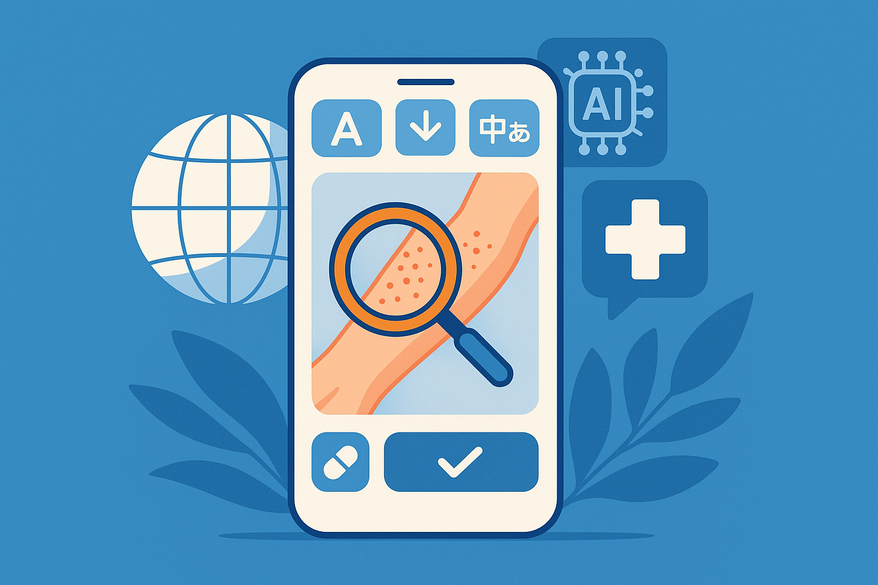How a Multilingual Rash Detection App is Transforming Inclusive Healthcare
Discover how a multilingual rash detection app transforms healthcare by overcoming language barriers and improving dermatologic care with AI technology.

Estimated reading time: 8 min
Key Takeaways
- AI-powered imaging and NLP enable users to capture, describe, and receive guidance in their preferred language.
- Bridging care gaps by providing structured, multilingual triage in regions with limited dermatology access.
- Inclusive design addresses skin tone diversity, literacy levels, and cultural nuances.
- Privacy-by-design features include on-device analysis, encryption, and user-controlled data.
- Future potential spans hybrid diagnostics, EHR integration, and expanded use cases beyond dermatology.
Table of Contents
- The Need for a Multilingual Rash Detection App
- Understanding the Multilingual Rash Detection App Technology
- Benefits of a Multilingual Rash Detection App Approach
- Challenges and Considerations
- Future Trends and Implications for Healthcare
- Conclusion and Call to Action
- FAQ
Section 1: The Need for a Multilingual Rash Detection App
Language barriers in dermatology often lead to miscommunication, delayed diagnoses, and poorer outcomes. When patients cannot accurately describe itchiness, burning sensations, or rash duration, clinicians miss critical clues.
Key challenges:
- Limited dermatologist access in low- and middle-income countries—often fewer than one specialist per 100,000 people.
- Misinterpretation of medical terms—words like “papule” or “vesicle” lack direct translations for low-literacy populations.
- Narrow skin tone representation—most resources focus on lighter skin, missing diagnoses on darker tones.
Inclusive care means coverage across:
- Language: Local tongues, dialects, and colloquial expressions.
- Literacy: Simple menus, audio prompts, and icons for low-reading proficiency.
- Skin types: Training datasets spanning the full Fitzpatrick scale.
Users can describe symptoms in their mother tongue and receive culturally adapted guidance. Evidence from Derma JMIR and PMC10335127 shows that multilingual triage significantly improves understanding and care adherence.
Section 2: Understanding the Multilingual Rash Detection App Technology
A multilingual rash detection app combines smartphone imaging, AI analysis, and localized interfaces. The typical workflow includes:
-
Photo Capture
• High-resolution image with prompts for focus, lighting, and framing. See tips for taking clear rash photos. -
Structured Questionnaire
• Questions on rash location, onset, duration, and symptoms. • NLP-powered forms adapt to language choice with voice-to-text or icons. -
AI Model Analysis
• On-device or cloud-based CNN inference recognizes lesion morphology. • Symptom-checker integration refines differential diagnoses. Learn more about how AI diagnoses rashes and the technical process of rash detection. -
Results and Triage
• Ranked list of likely conditions and urgency recommendations—self-care, primary care, or immediate consultation.
Privacy-by-design features:
- On-device inference to limit data transmission.
- Encryption in transit (TLS/SSL).
- User controls for image storage and deletion.
Section 3: Benefits of a Multilingual Rash Detection App Approach
For End Users:
- Clear Explanation: Plain-language descriptions, visual aids, and urgency badges reduce anxiety.
- Better Self-Care Adherence: Instructions in the user’s language improve follow-through and symptom tracking.
For Clinicians and Health Systems:
- Standardized Intake Data: Structured, multilingual questionnaires yield consistent outputs and faster teledermatology triage.
- Frontline Worker Support: Community health volunteers use local-language prompts to flag serious cases early.
Section 4: Challenges and Considerations
Developing a reliable multilingual rash detection app involves technical, cultural, and regulatory hurdles:
- Translation & Cultural Nuance: Localize medical terms into plain-language phrases reviewed by clinicians and translators.
- Representation & Performance: Training datasets must span diverse skin tones, ages, lighting, and local disease patterns.
- Privacy, Security & Regulation: On-device inference, encryption at rest/in transit, and compliance with GDPR, HIPAA, and local laws.
- Scalability & Integration: Feature parity across languages, offline functionality, and seamless escalation to teledermatology platforms.
Section 5: Future Trends and Implications for Healthcare
- Hybrid Digital Diagnostics: Combining image analysis, chatbots, guided triage, and clinician oversight.
- Expanded Use Cases: Wound assessment, medication adherence reminders, and chronic disease monitoring across languages.
- Health System Integration: Linking rash detection data to EHRs, automated referrals, and public health surveillance.
Conclusion and Call to Action
Developing a multilingual rash detection app advances equitable dermatologic care by:
- Improving comprehension with culturally adapted, plain-language guidance.
- Accelerating care delivery through AI-driven triage and telemedicine backups.
- Building trust via transparent privacy practices and local-language support.
A practical example is the AI-supported Skin Analysis App Rash Detector, which lets users upload images and receive an instant, multilingual report.

Which features matter most in your community? Share your priorities—language support, offline functionality, or teledermatology integration—to help shape the next generation of inclusive skin-care tools.
FAQ
What languages does the app support?
The app currently supports over 20 languages and dialects, with ongoing expansion based on user feedback.
How is my privacy protected?
All image analysis can occur on-device, and any transmitted data is encrypted. Users control image storage and deletion at all times.
Can the app work offline?
Yes, core features like photo capture and questionnaires are available offline; AI inference can run on-device without internet access.





